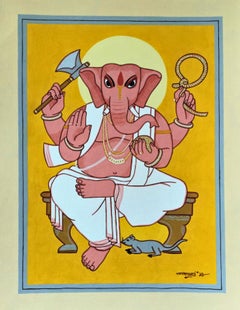Tempera Figurative Paintings
15th Century and Earlier Old Masters Tempera Figurative Paintings
Tempera, Panel
2010s Realist Tempera Figurative Paintings
Oil, Wood Panel, Tempera
2010s Realist Tempera Figurative Paintings
Tempera, Wood Panel, Oil
1940s American Modern Tempera Figurative Paintings
Tempera, Board
2010s Modern Tempera Figurative Paintings
Mixed Media, Tempera, Board
2010s Modern Tempera Figurative Paintings
Mixed Media, Tempera, Board
2010s Realist Tempera Figurative Paintings
Wood Panel, Tempera, Oil
Mid-20th Century Modern Tempera Figurative Paintings
Tempera, Gouache
2010s Contemporary Tempera Figurative Paintings
Canvas, Egg Tempera
2010s Minimalist Tempera Figurative Paintings
Canvas, Egg Tempera
1970s Contemporary Tempera Figurative Paintings
Tempera
1970s Modern Tempera Figurative Paintings
Tempera
2010s Contemporary Tempera Figurative Paintings
Canvas, Tempera
2010s Realist Tempera Figurative Paintings
Canvas, Egg Tempera
1970s Contemporary Tempera Figurative Paintings
Tempera
2010s Modern Tempera Figurative Paintings
Tempera, Board
1970s Contemporary Tempera Figurative Paintings
Tempera
Early 1900s Modern Tempera Figurative Paintings
Tempera, Watercolor
2010s Contemporary Tempera Figurative Paintings
Canvas, Tempera
Early 1900s Modern Tempera Figurative Paintings
Tempera, Watercolor
Mid-19th Century Modern Tempera Figurative Paintings
Tempera
Early 2000s Contemporary Tempera Figurative Paintings
Canvas, Acrylic, Egg Tempera
2010s Contemporary Tempera Figurative Paintings
Canvas, Emulsion, Ink, Tempera
16th Century Old Masters Tempera Figurative Paintings
Wood, Egg Tempera, Wood Panel
Early 2000s Contemporary Tempera Figurative Paintings
Ink, Oil, Egg Tempera
Early 2000s Tempera Figurative Paintings
Canvas, Oil, Tempera
2010s Contemporary Tempera Figurative Paintings
Canvas, Paper, Oil, Tempera
2010s Contemporary Tempera Figurative Paintings
Canvas, Tempera, Oil, Paper
2010s Contemporary Tempera Figurative Paintings
Egg Tempera, Panel
16th Century Renaissance Tempera Figurative Paintings
Tempera, Board
19th Century Renaissance Tempera Figurative Paintings
Gold Leaf
2010s Contemporary Tempera Figurative Paintings
Egg Tempera, Panel
2010s Contemporary Tempera Figurative Paintings
Egg Tempera, Panel
2010s Contemporary Tempera Figurative Paintings
Egg Tempera, Panel
2010s Contemporary Tempera Figurative Paintings
Panel, Egg Tempera
20th Century Other Art Style Tempera Figurative Paintings
Tempera
2010s Pop Art Tempera Figurative Paintings
Canvas, Tempera
2010s Contemporary Tempera Figurative Paintings
Marble
1950s Abstract Expressionist Tempera Figurative Paintings
Casein
1950s Abstract Expressionist Tempera Figurative Paintings
Casein
1940s American Realist Tempera Figurative Paintings
Oil, Board, Tempera
1980s Outsider Art Tempera Figurative Paintings
Plaster, Casein, Wood Panel
1990s Outsider Art Tempera Figurative Paintings
Mirror, Plaster, Casein, Wood Panel
2010s Realist Tempera Figurative Paintings
Tempera
Mid-19th Century Realist Tempera Figurative Paintings
Wood, Tempera, Egg Tempera, Wood Panel
Late 19th Century Gothic Tempera Figurative Paintings
Gesso, Oil, Tempera, Wood Panel
2010s Contemporary Tempera Figurative Paintings
Marble, Gold Leaf
Late 19th Century Gothic Tempera Figurative Paintings
Gesso, Oil, Tempera, Wood Panel
Late 18th Century Baroque Tempera Figurative Paintings
Egg Tempera
2010s Contemporary Tempera Figurative Paintings
Paper, Tempera
1960s American Modern Tempera Figurative Paintings
Casein
Early 19th Century Other Art Style Tempera Figurative Paintings
Paper, Tempera
Early 19th Century Other Art Style Tempera Figurative Paintings
Paper, Tempera
2010s Contemporary Tempera Figurative Paintings
Paper, Tempera
2010s American Impressionist Tempera Figurative Paintings
Egg Tempera, Panel
2010s Contemporary Tempera Figurative Paintings
Gold Leaf
2010s Pop Art Tempera Figurative Paintings
Canvas, Tempera
16th Century Mannerist Tempera Figurative Paintings
Tempera, Canvas



